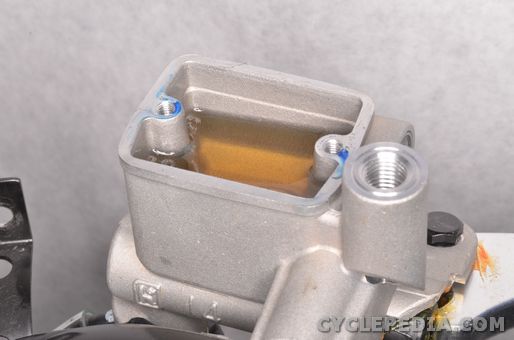Brake fluid is designed to transfer pressure in a hydraulic system. The fluid must be incompressible to function correctly. If air bubbles are in the fluid, the bubbles will compress as the pressure of the fluid increases. The compression of air inhibits the transfer of pressure from the master cylinder to the caliper piston/s. At the lever this gives a mushy feeling and reduces the power of the brake system. The brake system will require air bleeding if the fluid is drained, components are disconnected from the hydraulic circuit, or anytime the brake lever or pedal feels mushy.
The brake system must be able to tolerate high temperatures as converts kinetic energy to heat energy when slowing the wheels. The brake fluid must not boil under this intense heat. Brake fluid is rated by a minimum boiling point by the Department of Transportation (DOT). Almost all power sports vehicles with hydraulic brakes use a glycol based fluid rated DOT 3, DOT 4 or DOT 5.1. The higher the number the higher the boiling point of the brake fluid. Never use a brake fluid with a lower boiling point than specified. Also, never use a silicone based brake fluid (DOT 5) in a system that is intended to have glycol fluid.
Glycol brake fluid is hygroscopic, that is it absorbs moisture from the atmosphere. The moisture will lower the boiling point of the brake fluid over time. The brake fluid should be replaced every two years to combat this problem. Always use fresh brake fluid from a newly opened container to avoid using brake fluid that has already begun absorbing moisture. If the brake fluid is not changed it will continue to absorb moisture, and eventually it will crystallize and form deposits inside the brake system that can cause the seals to fail and components to seize.
Warning: Glycol brake fluid is very caustic and can damage paint, chrome and plastic. Wipe up any spills immediately. Glycol brake fluid is water-soluble, use a damp shop rag and water to clean brake fluid from the vehicle if needed. A dry shop towel may do more harm than good by spreading the caustic chemical on a painted surface. Always wear a pair of chemical resistant gloves, like nitrile, when working with brake fluid.
Inspection
Inspect the level and quality of the brake fluid. If the fluid is contaminated or crystallized it must be replaced. As the brake pads wear, more fluid will be used in the system to push the caliper piston/s out farther and the brake fluid level in the reservoir will fall. If the worn out pads are replaced with new pads, the brake fluid level in the reservoir will rise as the caliper pistons are now sitting farther back inside the caliper. Inspect the system for leaks if the brake fluid level drops quickly.

Place the vehicle on level ground and position the master cylinder reservoir so that it is level. Inspect the brake fluid level. Consult the service manual for the brake fluid inspection technique. Some models have a master cylinder reservoir with a window and indicator marking.

Other models have a fluid level line cast inside the master cylinder reservoir. Remove the cap and inspect the fluid level on these models.
Fluid Replacement

Remove the reservoir cap, rubber diaphragm, and diaphragm backing plate. The specified brake fluid type is often stamped on the reservoir cap.

Drain the old brake fluid out of the master cylinder reservoir with a suction device or remove the reservoir and poor it out.

Fill the reservoir with fresh brake fluid of the correct type as the fluid level drops during fluid replacement.

There are bleeder valves located on the calipers, and sometimes on other components like master cylinders and proportional valves. Pull off the rubber bleeder valve cap and crack open the bleeder valve. Use a box end wrench or a 6 point socket and ratchet to prevent rounding off the head of the bleeder valve the first time it is loosened. Snug the bleeder valve back down.

Connect an Mighty-Vac or similar suction tool to the bleeder valve.

Apply a vacuum with the suction tool. Open the valve and suck the brake fluid out of the valve. Do not let the master cylinder run dry or air will be introduced to the system. When the old brake fluid has been drained and the system is now filled with fresh fluid close the bleeder valve. Make sure the brake lever feel is firm and bleed the brake system as needed.
Brake Hoses and Banjo Bolts

Brake hoses are often joined to caliper or master cylinders with a banjo bolt and a pair of sealing washers. Always replace the washers when the banjo bolt is removed.

